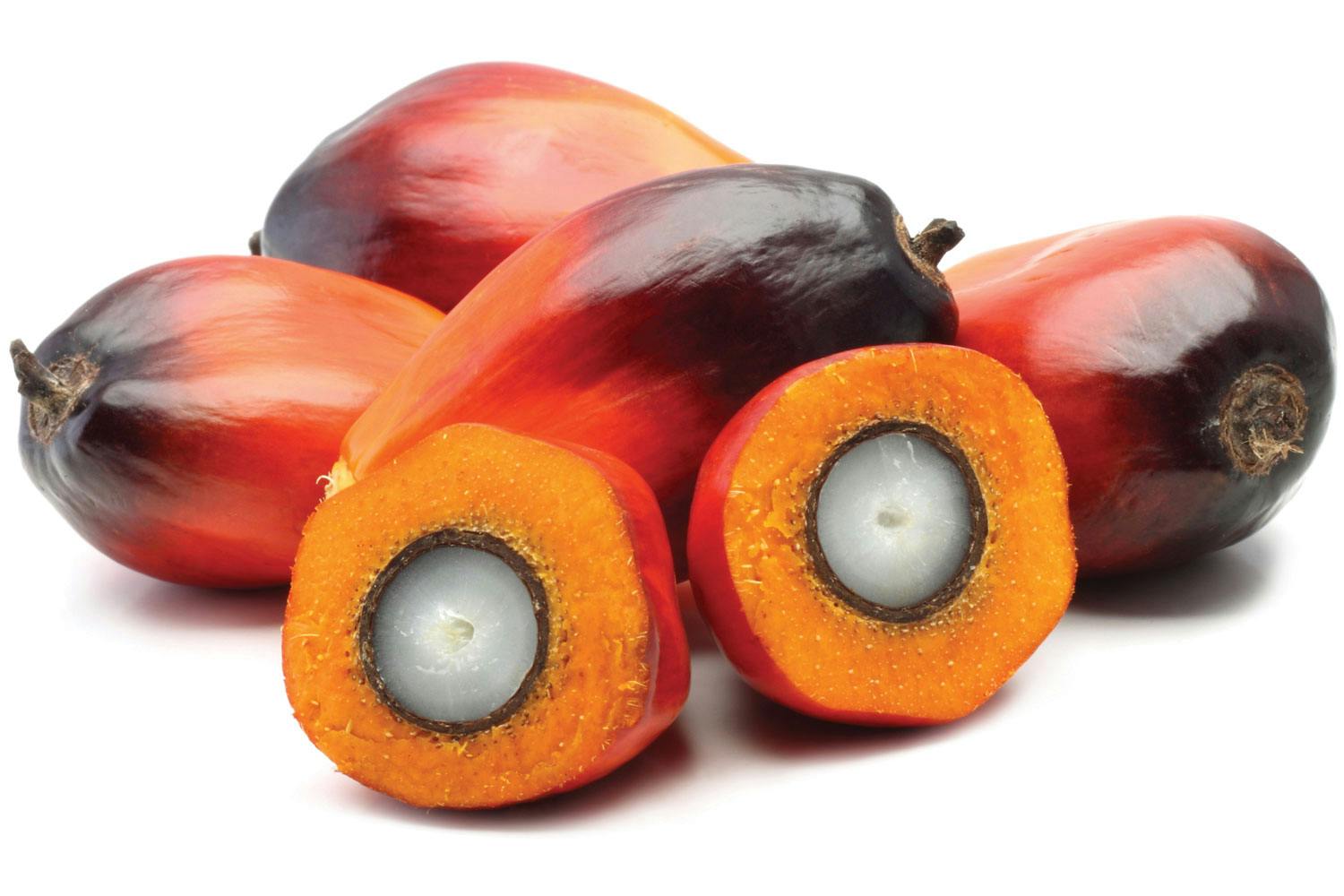Palm Oil is in Everything, and It’s Hurting More than the Orangutans
Inexpensive, often-invisible, and the source of environmental destruction: this is the story of palm oil.
Orange-red oil palm fruit produces two kinds of oil: “palm oil” from the flesh, “palm kernel oil” from the seed
We cook with it. We bathe with it. We use it for mood lighting. Palm oil is an ingredient in processed foods, cosmetics, hygiene products, biofuels, and candles; experts estimate it’s found in 50% of the items on grocery store shelves. Inexpensive to produce, palm oil contains no trans fats, and has a high melting point, making it versatile and easy to spread. The result: increasing demand. In 1996, global production totaled 16 million metric tons. By 2017, it was 60.7 million.
But there’s a problem. Palm oil may not cost much to produce, but it exacts a high price on the environment. And thanks to this often-invisible ingredient’s complex international supply chain, efforts to reduce that impact are proving challenging.
From virgin forest to grocery store
The story of palm oil begins with clearing tropical rainforests and peatlands for plantations of oil palm trees, which thrive on warmth, sunlight, and copious rainfall. The trees — native to West Africa — produce clusters of orange-red fruit year-round, and can be harvested every 10–14 days when mature. For the most part, oil palms don’t need much help, but some farms do use herbicides and insecticides. Oil palms produce 3.8 metric tons of oil per hectare annually — eight times as much as soybeans (.5 t/ha), and almost five times the yield of canola (.8 t/ha).
Palm fruit contains oil in its flesh (palm oil), and its seed (palm kernel oil). At diesel-powered mills, fruit and kernels are pressed to extract oil. The next stop is often a refinery, where bleaching improves the oil’s color, deodorization reduces its smell, and “fractionation” can create different oils suited for different purposes. Then, the oil is shipped all over the world.
Palm oil is the most consumed oil in the world.
The US Department of Agriculture says palm oil is the most consumed oil in the world, and its non-food uses are also increasing. India, China, Europe, and Pakistan are the top importers, collectively using more than half of the global supply. In Asia, it’s used in home cooking. In Europe and the US, most demand comes from manufacturers for everything from Oreos to toothpaste. You can find it in Silk soy milk, Secret deodorant, Nutella, Jergens lotion, instant noodles, and Girl Scout cookies.
Palm oil and environmental devastation
Malaysian and Indonesian plantations make up about 85% of the industry, with Guatemala, Benin, and Thailand among the other top producers. Areas with low wages and abundant labor often welcome palm plantations — despite the industry’s history of slavery, child labor, and land-theft — because of their potential to lift workers out of poverty.
Around the world, the business of palm oil harms the environment. During conventional cultivation, forests are cleared for plantations, bringing biodiversity loss, human-wildlife conflict, and habitat destruction affecting many species, notably the orangutan. A recent International Union for Conservation of Nature report notes that 50% of all deforestation on Borneo between 2005 and 2015 was driven by palm oil development.
This deforestation also contributes to climate change; the conversion of forests to palm oil plantations releases carbon dioxide that had been absorbed by old-growth forests. The Union of Concerned Scientists estimated in 2013 that 10% of global greenhouse gas emissions come from tropical deforestation.
Given all the chemicals, sugars, fats, and allergens shoppers are already trying to avoid, palm oil is low on the list, if it’s even on the list.
These impacts have proven hard to combat, in part because palm oil is rarely the end commodity. Richard Zimmerman, executive director of New York-based non-profit Orangutan Outreach, calls it a “pervasive yet hidden” problem. Given all the chemicals, sugars, fats, and allergens shoppers are already trying to avoid, he says, “Palm oil is low on the list, if it’s even on the list.”
Palm oil and its derivatives appear under a multitude of monikers, from “palm kernel oil” and “partially hydrogenated palm oil” to “sodium lauryl sulfate” and “glyceryl stearate.” Other names, according to the Rainforest Action Network, include “stearic acid,” anything that includes “palmitate,” and “elaesis guineensis” (the oil palm’s Latin name). Try finding products in your grocery store without these. Not that all these terms always mean palm oil — some are occasionally derived from other oils. But companies likely can’t guarantee that, and there’s no way of knowing from reading a package.
So how do we change things? One group trying to answer that question is the Roundtable on Sustainable Palm Oil (RSPO), a 4,000-member-strong industry non-profit. Its approach includes offering financial incentives to stakeholders along the supply chain in return for implementing best practices.
RSPO members must demonstrate that plantation land was purchased, not stolen, and that they offer safe conditions for workers. The RSPO prohibits clearing primary (never-logged) forests and imposes requirements like: obtaining free, prior, and informed consent from locals for new plantings; analyzing and protecting fragile soils and areas of high-conservation value; and mitigating carbon impacts in place.
But right now, only about 20% of palm oil is RSPO-certified, and critics think the group’s approach still doesn’t go far enough. Greenpeace’s Senior Palm Oil Campaigner Diana Ruiz says investigations show that brands shift responsibility for palm oil sourcing problems onto traders, and traders don’t enforce on their end. “Once you get … all the way to the grower, there is no monitoring being done,” she says — and no good way to address violations.

Beyond the produce section, palm oil can be found in almost everything in your grocery store, from from Oreos to toothpaste and beyond.
The future of palm oil
Palm oil has a long supply chain, which makes reducing its use complex. “Historically, companies have not paid attention to what happens at the farm level, because [palm oil] is a secondary ingredient,” says Neil Blomquist, a spokesperson for the education and advocacy group Palm Done Right.
That may be changing, as palm oil gets more publicity. Still, places where palm grows see a clear economic boom from the industry, and there’s always a market for cheap consumables.
“It’s a difficult industry to regulate for that reason,” Blomquist says. “There’s been a growing demand for palm oil, the lowest-cost oil that can be produced. So, increasing demand with an increasing population in the world is really what’s driving the problems… with more and more rainforest being destroyed.”
Historically, companies have not paid attention to what happens at the farm level, because palm oil is a secondary ingredient.
Ending the use of palm oil may not be the answer. “Going to a boycott could cause more problems,” says Dan Strechay, the RSPO’s US outreach and engagement representative. “Because if we don’t buy palm oil — or ingredients that contain palm oil — it’s not like we snap our fingers and we have additional materials to put in. Something else has to be grown to replace it, and other oil seeds may require more land.”
But continuing as we are means ignoring the true costs of palm oil: to the environment and people living in palm-oil-producing areas. Says Zimmerman,“If the humans aren’t doing well, the orangutans are not going to do well.”
So, what do we do now? Eating fewer processed foods, buying locally, and otherwise voting with your dollars is a start. Keeping companies accountable for meeting their stated deadlines around sourcing sustainable palm oil is also key.
Eating fewer processed foods, buying locally, and otherwise voting with your dollars is a start.
Ruiz says the next step is asking suppliers and traders to create more transparency around their reporting, and the public can help. “We have huge influence over these brands,” she says. “The key here is to use that buying power we have as consumers and demand that companies do better.”
Print Issue: Summer/Fall 2019
Print Title: The Story of Palm Oil
